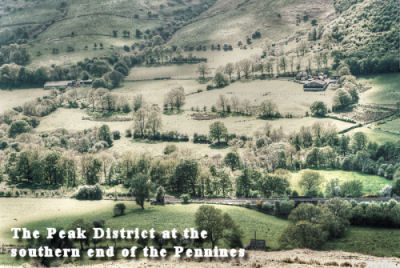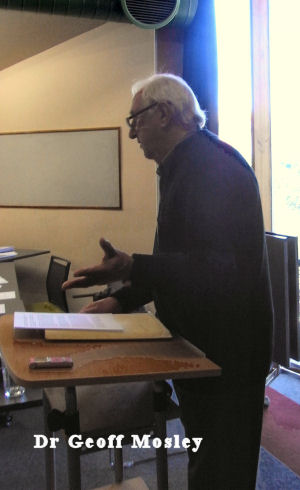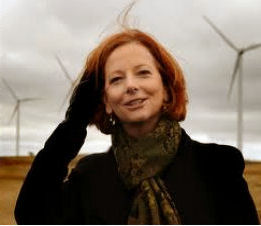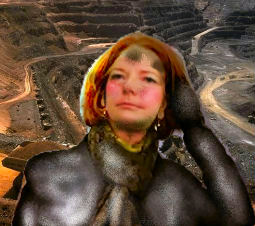Geoff Mosley: 60 years in conservation movement, the lessons learned, and the way ahead
 "Wind turbines are a compulsory backdrop for Julia Gillard when she is talking about the carbon tax but how often have you seen an image of her farewelling one of the huge coal laden boats at a Queensland port or staring into a giant open cut coal mine in the Hunter Valley? You could say that wind turbines help to mask the truth that there is a continuing growth in the usage of fossil fuels and in energy use generally." The decline in real environmental politics: despite the rising dangers of economic and population growth, an increasingly sidelined mainstream conservation movement finds false comfort in endless damage control and symbolic activity. The WW2 generation lived the community gardens, food and petrol rationing that are now goals of oil depletion awareness groups today. We were much more sustainable then. The way forward in a steady state economy would include equality and sustainability. Dr Mosley also drew a useful distinction between 'equality' and 'equal opportunity'.
"Wind turbines are a compulsory backdrop for Julia Gillard when she is talking about the carbon tax but how often have you seen an image of her farewelling one of the huge coal laden boats at a Queensland port or staring into a giant open cut coal mine in the Hunter Valley? You could say that wind turbines help to mask the truth that there is a continuing growth in the usage of fossil fuels and in energy use generally." The decline in real environmental politics: despite the rising dangers of economic and population growth, an increasingly sidelined mainstream conservation movement finds false comfort in endless damage control and symbolic activity. The WW2 generation lived the community gardens, food and petrol rationing that are now goals of oil depletion awareness groups today. We were much more sustainable then. The way forward in a steady state economy would include equality and sustainability. Dr Mosley also drew a useful distinction between 'equality' and 'equal opportunity'.
All subheadings were created by Candobetter Editor. Original speech had no subheadings.

Talk to Sustainable Population Australia (Victorian and Tasmanian Branch) Balwyn Library 7 July 2012
(This milestone environmental talk was superbly organised and compered by Jill Quirk, President of Sustainable Population Australia, Victoria and Tasmania Branch, with the help of the SPAVic Committee.)
Geoff Mosley:
Many thanks for inviting me here to speak to you this afternoon. What I want to do is to take you on a conservation journey – mine – extending over some 60 years to see if there are any lessons to be learned.
Influences on conservation of Great Depression, fuel shortage and WW2

Of course, everything we experience at any one time has been greatly affected by what has gone before. I began my conservation activities in the early 1950s but what happened then was influenced by two enormously significant previous events – the Great Depression of the 1930s and the Second World War of the 1940s. These were times when there was slower population growth and greater levels of self sufficiency. During the war we were told to “Dig for Victory” but that of course was not all we were digging for.
Community gardens were everywhere There were of course many economies, including food and petrol rationing and a simpler way of living all round.
War and Land-use Planning: Britain's first national park
What is perhaps not so widely realised though is that the War created a resolve to do things better in the way of national planning. ‘Post War Reconstruction’ as it was generally called wasn’t just about picking up the pieces caused by the War and, looking back, the amazing thing is that in Britain the thinking about this began in earnest in 1942 – in the middle of the War.
I mention this because it is relevant to how I came to be involved with conservation. I was extremely fortunate to be born in the Peak District in the southern Pennines of England. The Peak made me into what I have been ever since - a geographer and a conservationist. The geography interest came from understanding the relationship between the rocks, the vegetation and the land use. The conservation from the fact that in 1951 the area became Britain’s first national park, protecting the landscapes of the privately owned land through planning. Half of the population of England and Wales lived within 60 miles of the Park’s boundaries and during the 1930s there was considerable pressure on the area for the development of its resources. Clearly also, surrounded by cities, there was a potential for the development of dormitory suburbs for commuters.

In 1951 this kind of development was stopped in its tracks. Fast forward to the present day and national parks and ‘areas of outstanding natural beauty’ cover nearly a quarter of England and Wales. And they are secure. In 61 years there have been no boundary changes to the Peak District National Park, the population is less than it was when it was founded and it receives 23 million visitors a year. Studying this approach for my Master of Arts degree was an obvious choice which helped make me into a lifelong advocate for its use in Australia.
Suez Canal Crisis: has anything changed?
My next experience was as an Education Officer in the Royal Air Force. This was the time of the Suez Canal Crisis and the first of several scares concerning global oil supply. For the first time the concept of peak oil was on the current affairs menu. Has anything changed? Will the Straits of Hormuz be the scene of a similar crisis?
Canberra Bush Walking Club
Finishing my National Service I moved first to Canada and then New Zealand where I experienced first hand another kind of national park system which had begun to be established in the 19th century on public land. Arriving in Australia in 1960 I decided to study the land use and conservation needs of outdoor recreation in Tasmania for a PhD. A keen bush walker from an early age in 1961 I helped to found the Canberra Bush Walking Club.
All of this laid the foundation for me to make a contribution to the development in Australia of systems of protected areas involving different protection aims including wilderness areas and protected landscapes/seascapes and for the zoning of individual parks Located first in Newcastle then in Canberra I was again well placed to make a contribution to several ground breaking developments including the NSW national parks and wildlife legislation of 1967, the development of a pioneering zoning plan for Kosciusko National Park, and the introduction of a national heritage protection scheme.
1966: Conservation 101 course at ANU and Australian Conservation Foundation work
In 1966 I became part of the staff of the fledgling Australian Conservation Foundation. Not surprisingly this body quickly became involved with wildlife conservation and national parks advocacy. The national park was seen as the best method of securing an area against destruction but the events at the Lake Pedder National Park in the early 1970s was the catalyst for an approach involving the federal Government. This led to the protection of the Great Barrier Reef in 1975 and to the stopping of sand mining at Fraser Island and Cooloola at about the same time. From the early 1980s we had the first Australian World Heritage Areas including the Great Barrier Reef and in 1983 this gave the federal Government the power to stop the damming of the lower Gordon and Franklin Rivers.
In 1966 I my personal understanding of what was needed in conservation was broadened when at ANU I gave what I believe was the first year long course Australian university course in the conservation of natural resources. In 1968 I became the full time Assistant Director of the ACF and we moved into what, looking back, was the most hopeful period in Australian conservation history.
1960s and 1970s critics of dysfunctional nature of economic growth (Sir Garfield Barwick, Pres. ACF)
In the late 1960s and early 1970s environmentalism began to shape up as a major political force. The Club of Rome was formed in 1968 , Paul Ehrlich’s 1968 ‘The Population Bomb’ and Donella Meadows’ 1972 ‘The Limits to Growth’ books attracted a wide readership and the developing conservation movement produced a new perspective by criticising the dysfunctional nature of economic growth. Sir Garfield Barwick, President of the Australian Conservation Foundation, called economic growth “a false and unsatisfying god”. In a speech to engineers titled ‘Economic Growth and the Environment’ (published by the ACF in 1971),
Barwick quoted extensively from John Stuart Mill’s 1848 book Principles of Political Economy concerning the advantages of a stationary state combined with growth in creativity and suggested replacing our economic growth system with “a stationary system with cyclical re-use of resources”. In December, 1969 in a letter to The Age Barwick had referred to ACF’s role as being the development of a “blueprint of a conservation policy for the Nation.”
Mill’s stationary state alternative, rebranded as the ‘steady state economy’, also began to receive more attention at this time, largely, through the work of Herman Daly. Daly for instance edited the publication ‘Toward a Steady State Economy’ in 1973 and in 1980 lectured at well attended public meetings in Australia.
Governments ignored opportunity
Barwick in his 1971 paper argued that our “entire pattern of thinking has to be radically altered”. But unfortunately a radical approach was not to be. That did not stop us from putting more emphasis into taking stock and beginning to produce conservation studies and plans from a national, state regional and local perspective. Beginning in 1980 the world began a phase of producing conservation strategies and state of the environment reports at all geographic levels. In Australia our ‘National Conservation Strategy’ was published in 1983 and this was followed by the ‘National Strategy for Ecologically Sustainable Development’ in 1992. The first of several national state of environment reports - ‘State of the Environment in Australia’ (in 2 volumes) prepared by the Department of Arts, Heritage and Environment was published in 1985. None of these documents appear to have had any major influence on policy. In fact if you look back at them even though they got watered down by Government and the bureaucracy the suggestions in them are still ahead of the thinking today.
Successive population reports brushed off

Also, I believe it is also true to say that none of the various population reports of the last four decades, beginning with the Borrie report in 1975 and including last years ‘sustainable population’ discussions, have made any difference. In 1986 as a member of the National Population Council I wrote a report which suggested we should aim for a population not greater than 21.5 million by 2030 and in 1994 the Australian Academy of Science suggested a cap of about 23 million by 2040. The situation is that with the present rate of increase of about 1.5% our population is set to reach about four times those suggestions by the end of the century. The discussion of population policy is largely divorced from the bigger question of where Australia should be going. Kelvin Thomson rightly called it a missed opportunity to map out a direction for Australia’s future.
It is an extremely sad thing that we are not facing up to the reality of the situation, that we are more addicted to perpetual economic growth than ever when the need for an entirely new way of living could not be more obvious to those who bother to think about the matter.
Mainstream conservation focused on damage-control, carbon emissions rather than overproduction
So where exactly is the conservation movement today? Generally, it still focuses most of its efforts on damage control or what we call ‘mitigation. In other words it is basically reactionary. Let me take an example – human influence on climate through carbon emissions.
For many in the environment movement this is ”the only big issue”. Some are fixated on it. We certainly put a lot of our effort into describing how bad this will be for the environment if we do not curb it, but the almost universal approach is one of mitigation - to work for a switch to non or less carbon emitting energy sources with little concern about either the overall level of energy use or the relationship of energy use to economic growth. We treat it as a carbon emission reduction problem when the basic problem, the cause, is the over production of everything including carbon – treating the world as an infinite source of materials. An Emperor is wearing no clothes situation if ever there was one.
The present situation is that the proportion of energy derived from renewable sources is increasing but the amount of fossil fuels being used is also increasing as is, of course, the total amount of energy being produced and the total carbon emissions. This is because
in a perpetual economic growth driven system the demand for energy endlessly increases. The result is that while our efforts in relation to developing more renewable energy have reduced the potential impact of energy use on the atmosphere - in the sense that is without renewables the emissions could have been bigger - the overall impact on the earth from higher levels of energy development and use is increasing. Even if we did achieve a goal of zero carbon emissions, all of the other problems associated with energy fuelled economic growth would still remain.
Fragmented and partial approach to problem of perpetual economic growth driven economy
There are of course many other examples of this sectional approach which I could refer to. We do not just deal with every problem separately but quite often we often deal only with a part of the perceived problem. For instance here in Australia while we have decided to put a price on carbon the Government is totally ignoring the problems created by Australia’s massive coal exports. Another inconvenient truth. Even looking at it from the pollution viewpoint it has been estimated that the planned expansion of Australia’s mining will by 2020 add 11 times the amount of carbon to the atmosphere that the carbon tax will save. Similarly, the conservation movement is concerned about Coal Seam Gas exploitation on water, agriculture and natural areas such as the Great Barrier Reef but it ignores the wider effects of its use in terms of feeding economic growth. Of course Australia is not alone in being firmly committed to increasing the use of fossil fuels. Around the world coal production over the last decade has had an annual growth rate of 4.6% and in 2011 total production was 7.7 billion tonnes. In the next quarter century China, which already generates 70% of its electricity with coal and plans to bring it down to 63% by 2015, is also planning to add 600 gigawatts of coal fired power capacity, as much as is currently generated today by coal in the US, Europe and Japan put together. We kid ourselves if we think this situation is going to change. There are huge coal resources in Russia and the USA as well as Australia and I doubt whether the successor to the Kyoto Protocol will alter the present situation where countries are not responsible for the emissions from their exports.
Focus on perpetual mitigation deludes us into believing our approach will eventually work

Another major consequence of this approach of focusing on mitigation, practised by both Governments and the conservation movement, is that in doing this we are helping to create the illusion that this approach will work, that it is not the underlying system which is at fault but some aspects of the way it operates, something that can be fixed given time. For instance, that we can reduce emissions without tackling the economic growth system which drives the increased use of fossil fuels. In other words in doing this we are actually propping up a bad system and enhancing its legitimacy. ‘Green washing economic growth’ is probably a more accurate metaphor for what is going on. Or, maybe ‘green whishing’ in the case of wind turbines.
Wind turbines are a compulsory backdrop for Julia Gillard when she is talking about the carbon tax but how often have you seen an image of her farewelling one of the huge coal laden boats at a Queensland port or staring into a giant open cut coal mine in the Hunter Valley. You could say that wind turbines help to mask the truth that there is a continuing growth in the usage of fossil fuels and in energy use generally.
The closest that we ever come these days to adopting a different approach of tackling the whole is to talk vaguely about ‘transforming society’ or ‘making the transition’.
Coal production threatens hard-won national park and reserves system including Barrier Reef World Heritage
I began by mentioning the conservation movements efforts on protected areas and here clearly there has been significant progress. The national reserve system in Australia in 2010 covered over 13% of the terrestrial environment (over 40% in Tasmania). So let me return now to where I began with the efforts to create extensive systems of protected areas around the world. In the late 1960s Sir Macfarlane Burnet said that with world population out of control parks and nature would be eventually crowded out of existence If these parks are the greatest achievement of the conservation movement, providing inspiration for a more comprehensive approach, it is essential that they be maintained. Unfortunately, things are not looking good. Australia’s number one icon the Great Barrier Reef, added to the World Heritage List in 1982, is facing some serious threats from the expansion of coal export including 45 proposals for coastal development including 11 new port proposals and thousands of extra vessels sailing through the Reef
So what is the answer? Surely, it is also to find a better way, one that deals not just with the dysfunctional relationship between people and their physical environment but one which also provides for a better social relationships – a major system change to steady state economy alternative first outlined by John Stuart Mill in 1848 and referred to by Garfield Barwick over 40 years ago. It will need to be a change which affects all aspects of society. Our present institutions have been developed to facilitate growth and therefore must be changed
Steady state economy requires major systemic change
One cannot keep the means of economic growth and change the ends to a steady state economy. If these remain there is little chance of an effective change.
Decoupling is also a concept suggested by some but it is obvious that gains in efficiency could never keep up with endless economic growth and the increased consumption.
Efficiency gains generally lead to increased consumption of natural resources. To work decoupling must be accompanied by an end to economic growth. The best avenues to greater equity in a finite world are through smaller populations and redistribution.
The lesson is that the solution must be comprehensive and the different parts must be complementary, not in opposition to one another.
DEFINITION AND PRINCIPLES OF THE STEADY STATE ECONOMY
CASSE defines a steady state economy as being one “with a relatively stable, mildly fluctuating product of population and per capita consumption”.
Herman Daly’s short definition for the steady state economy is “one that develops qualitatively (by improvement in science, technology and ethics) without growing quantitatively in the physical dimensions”.
Our current universal ‘economic growth’ model by contrast involves an increase in the production of goods and services - an endless increase in the amount of materials processed, consumed and disposed of as waste. This concept of economic growth started out as a means to the end of creating wealth and power and improving standards of living in a less crowded world but it and population growth became goals with such things as competition, trade, and profit making developed as major means to those ends. Although running up against the physical limits of the world, change is unlikely unless we find another way or wait until there is a ‘planetary shipwreck’.
The principles which underpin the steady state economy alternative are concerned with both the relationship of people and the environment and the relationship between people.
The FIRST PRINCIPLE concerns the rate and scale of resource use. Instead of endlessly increasing the use of resources to provide for and stimulate more consumption we will use resources at a sustainable rate – at a rate related to the natural processes of renewal, and the capacity of the environment to deal with waste. In other words in the steady state economy there will be a stable level of material throughput at a level and scale which can be maintained indefinitely. This of course includes complete reliance on renewable resources including energy.
The SECOND PRINCIPLE concerns the goal of social equality. It is the opposite of our present system which is inequitable as well as being materialistic, competitive, individualistic and elitist. Our present system justifies disparities in wealth, education, health and justice by saying that these are necessary to provide an incentive for growth in the form of rewards for those who do well and that growth will improve standards of living for all through the trickle down effect. In the steady state, in complete contrast, there will be full and true equality everywhere. Co-operation will replace competition as the main goal and form of social interaction.
MAIN FEATURES OF THE STEADY STATE ECONOMY:
So, what will be the main features of the steady state economy?
To begin with in the steady state economy, to achieve sustainability, people will live within the earth’s means, relating their use of its resources to its environmental capacity through their close relationship to it. They will have direct control of the environment where they live and full respect for it. They will be as concerned for the long term welfare of the environment as they are for its welfare during their lifetimes. This will be achieved partly by people living in small communities, producing most of their own food and other materials. In this way they will have not only have a close knowledge of their environment but an absolute stake in its future.
At the same time the new relationship with people will involve true equality. Not today’s flawed concept of equal opportunity for all to climb the ladder to success (which along with the alleged need for competition is used as a justification for inequality) but equal treatment in every respect, including equal access to food, housing, and other services. It will be a non-hierarchical society.
No one will be superior to another. There will be respect for all. In the steady state people will gain satisfaction from developing and exercising their skills and from contributing to the well being of the community. It is important with regard to this step that that it is understood that inequality is one of the major facilitators of the Economic Growth system and that unless it is dismantled it will impede the move to a Steady State Economy.
I trust I have said enough to suggest not only that there is hope because there is a better way but also to emphasise that if we are going to have any chance of success it will need a concerted effort a change of focus and by the conservation movement. Over to you.
Geoff Mosley
6/7/2012


Recent comments